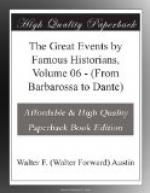The Naiman chief, Tayang, had his skull encased in silver and bejewelled, and afterward used it as a ceremonial cup; a custom very frequent in Mongolia. Such cups have been lately met with in Europe, one of which was exhibited at the great exhibition of 1851, where it was shown as the skull of Confucius. Another, or perhaps the same, which was encased in marvellous jeweller’s work, has been lately destroyed; the gold having been barbarously melted by the Jews. By the death of Wang Khan, Temudjin became the master of the Kerait nation, and thus both branches of the Mongol race were united under one head.
He now held a kuriltai, where he was proclaimed khan. There is some confusion about the period when he adopted the title of Genghis, but the probability is that he did so three years later. The earlier date (1203) is the one, however, from which his reign is often reckoned to have commenced.
VENETIANS AND CRUSADERS TAKE CONSTANTINOPLE
PLUNDER OF THE SACRED RELICS
A.D. 1204
EDWIN PEARS
In the treaty arranged at the end of the Third Crusade (1192) it was stipulated that all hostilities between the Christians and the Moslems should cease. The Fourth Crusade (1196-1197), which is sometimes considered merely as a movement supplementary to the Third, forced renewed hostilities, against the wishes of the Palestine Christians, who preferred that the three-years’ peace should continue. The Fourth Crusade ended disastrously, those who remained longest to prosecute it being finally cut to pieces at Jaffa in 1197. The travellers returning to the West from Syria besought immediate help for the Christian survivors there. The Byzantine empire had fallen into decrepitude, and the Latin kingdom of Jerusalem was reduced to a mere strip of coast. Only by prompt action could it be hoped to save any portion of it from complete wreck.
Innocent III, who became pope in 1198, well understood the meaning of the Moslem triumphs. The four crusades had already greatly extended the papal jurisdiction, and Innocent himself was the moving spirit of the Fifth, although an ignorant priest named Fulk also preached it with a success almost equal to that of Peter the Hermit in the first expedition. Vast numbers of warriors took the cross, though no king and only a few minor princes joined them. Most famous among the leaders were Boniface II, Marquis of Montferrat, and Baldwin IV, Count of Flanders.
Venice joined the crusaders under the lead of her doge, Henry Dandolo, then more than ninety years old. When ambassador at the Byzantine court (1173) he was blinded by order of the emperor Manuel I, and revenge was probably one of the motives which took him again to the East. The Venetians, being asked to transport the crusaders,




